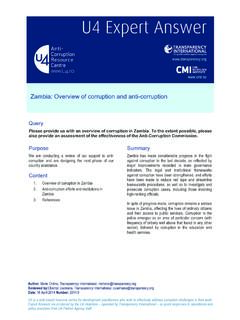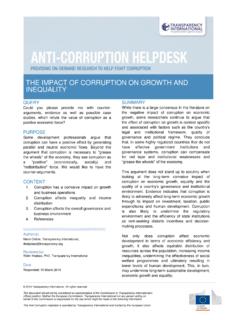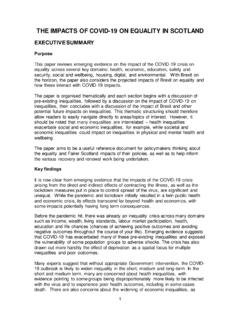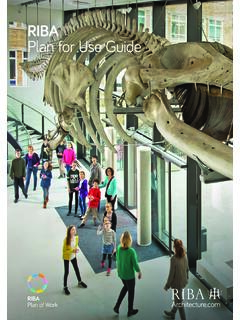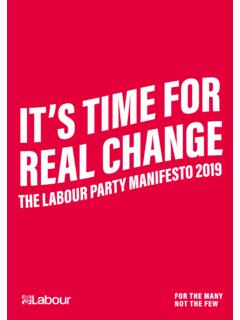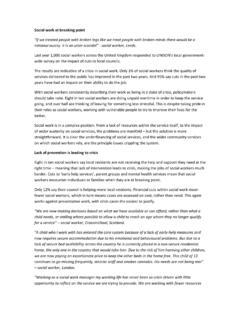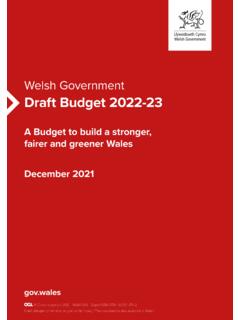Transcription of ANTI-CORRUPTION MECHANISMS IN THE BANKING SECTOR
1 2014 Transparency International. All rights reserved. ANTI-CORRUPTION MECHANISMS IN THE BANKING SECTOR QUERY Please provide a short introduction to ANTI-CORRUPTION MECHANISMS which may curb corruption risks in the BANKING SECTOR as well as recommended reading resources related to the issue. PURPOSE To provide background research for a policy brief on standard MECHANISMS to help the government strengthen BANKING transparency, integrity and stability in Afghanistan. CONTENT 1. Corruption risks in the BANKING SECTOR 2. Regulatory and non-regulatory tools to counter corruption and promote integrity 3.
2 References and further reading \\\\\\\\\\\\\\\\\\\\\\\\\\\\\\\\\\\\\\\\ \\\\\\\\\\\\\\\\\\\\\\\\\\\\\\\\\\\\\\ Author(s) Suzanne Mulcahy PhD, Transparency International, Reviewer(s) Dieter Zinnbauer PhD, Transparency International Date: 13 August 2015 SUMMARY Corruption in the BANKING SECTOR has manifested itself in many scandals involving money laundering, rate rigging and tax evasion, all of which undermine the public s trust in financial institutions. Since the global financial crisis of 2008/2009, a number of high-level reforms have been undertaken, both at the regulatory level and at an operational level within BANKING institutions. Among the key ANTI-CORRUPTION tools to consider within the BANKING SECTOR are: having strong anti-bribery rules, robust anti-money laundering rules, managing risks associated with politically exposed persons as BANKING clients and tools to counter BANKING secrecy.
3 To effectively counter corruption and promote integrity, these rule-based approaches should be complemented with measures to engender a culture of integrity in banks and financial institutions. These can include codes of conduct, public oaths, building incentives for integrity in remuneration packages and careful management of conflicts of interest. These measures should be accompanied by strong oversight and measures to ensure there is no impunity for wrongful behaviour. ANTI-CORRUPTION MECHANISMS IN THE BANKING SECTOR 2 1 CORRUPTION RISKS IN THE BANKING SECTOR Banks have a significant impact on the safety and soundness of the world s financial system, and the overall economic health of countries. The fallout from the global financial crisis of recent years, and of the bank bailouts and government austerity programmes that ensued, has brought this impact into stark relief.
4 Corruption in the BANKING SECTOR has manifested itself in many scandals involving money laundering, rate rigging and tax evasion, all of which undermine the public s trust in financial institutions (Transparency International 2015). It has been noted that risk taking is intrinsically involved in the business of BANKING and that this can lead to unethical conduct at the expense of the public interest (Dewatripont and Freixas 2012). Indeed it is well established that excessive risk taking played an important role in the most recent financial crisis (Bebchuk and Spamann 2009; Dewatripont and Freixas 2012). Whether this was the result of skewed incentives built into remuneration schemes, shareholders appetite for risk, a general culture of risk or the financial market s short termism or a combination of these factors remains an unresolved question (Dewatripont and Freixas 2012).
5 The financial crisis triggered many reform efforts. A 2013 KPMG report noted that for banks, the single most pervasive driver of change is the regulatory agenda (KPMG 2013). In the US, the Volcker Rule, a key provision of the 2010 Dodd-Frank Act, prohibits banks from conducting certain investment activities, and limits their ownership of and relationship with hedge funds (Fortune 2015). This structural separation is meant to encourage banks to take different approaches to retail and investment BANKING . The Basel III standards, agreed in 2011, are designed to ensure banks have enough liquidity to handle a potential run on funds, although, like many reforms, have been subject to intense lobbying by banks and have been delayed in their implementation (New York Times 2013).
6 In Europe, the Libor rate-fixing scandal led to the amendment of the Market Abuse Regulation to impose minimum fines for insider trading and criminal sanctions for manipulating benchmarks such as LIBOR. Another area of increasing focus is anti-money laundering rules and know your customer regulations (KPMG 2013). Alongside such financial reforms, many argue that attention must be paid to non- financial risks, including those posed by a bank s conduct. Addressing such risks requires nurturing a healthy culture of integrity within institutions, incentivising ethical behaviour and ensuring those involved in misconduct are held accountable for it (Transparency International 2015). It is widely recognised that any attempt to address the risks of corruption in the BANKING SECTOR must involve a joint effort by the BANKING industry, regulators and supervisory bodies (G30 2015).
7 It is important to note that successfully countering the risks of corruption in the BANKING SECTOR rely on certain fundamentals to be in place: respect for the rule of law, a strong and independent judicial system, and protection for whistleblowers who report corrupt or unethical practices within public and private institutions. Furthermore, in all contexts, a centrepiece of financial integrity is an independent, sufficiently resourced regulator. It is also worth noting that most of the literature on ANTI-CORRUPTION MECHANISMS for the BANKING SECTOR focusses on developed economies, although many of the lessons are likely to be transferable to banks in developing countries if the above fundamental conditions are met. This paper draws mainly on the literature on financial integrity in developed economies.
8 It is important to note that in developing countries, a major corruption risk is the abuse of banks to bankroll political party corruption through cronyism and the issuing of substandard loans among other devices. Countering this type of corruption requires in the first instance good internal audit functions, strong internal governance in the form of competent boards, independent rating agencies and well-resourced and independent regulators that can blow the whistle on such forms of corruption. The rest of this paper outlines some ANTI-CORRUPTION MECHANISMS which fall under the legal and regulatory umbrella and following that, summarises some of the internal MECHANISMS which banks can adopt to address corruption risks from within and promote ethical conduct among employees.
9 ANTI-CORRUPTION MECHANISMS IN THE BANKING SECTOR 3 2 REGULATORY AND NON-REGULATORY TOOLS TO COUNTER CORRUPTION AND PROMOTE INTEGRITY Legal and regulatory MECHANISMS Anti-bribery and anti-money laundering rules Bribery and money laundering are two of the key types of corruption to which banks are exposed. Among the general factors that place financial institutions at risk of being involved in bribery are: operating in corrupt environments, interacting with public officials, providing services to high-risk sectors (defence, construction) and the use of agents, counter-parties, relying on subsidiaries, or entering into joint ventures (Transparency International UK 2010: 20-21). Given these risks, the most fundamental tenet of an ANTI-CORRUPTION framework for the BANKING SECTOR is a sound anti-bribery programme.
10 The UK is often cited as having the strongest anti-bribery legislation in the Bribery Act (2010) as it criminalises the actions of bribing, receiving a bribe, bribing a foreign public official and, uniquely, failing to prevent bribery (TI-UK 2010: 41). Transparency International s Business Principles for Countering Bribery provide a framework for companies to develop comprehensive anti-bribery programmes (Transparency International 2013). Effective anti-money laundering (AML) MECHANISMS are essential to prevent and detect corruption, both in the financial SECTOR and in non- financial sectors such as real estate and casinos. A bank s client base presents serious risks. Through its clients, a bank might become complicit in laundering the proceeds of crime, including corruption (Transparency International 2015).



